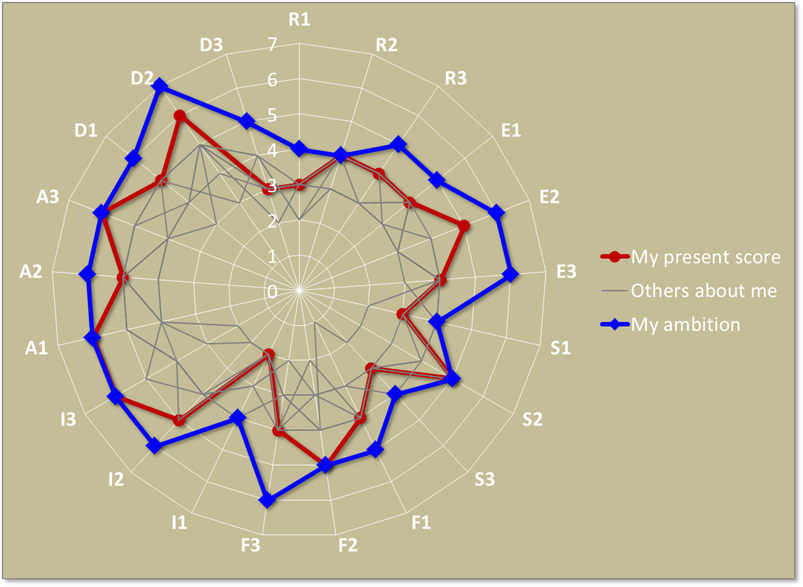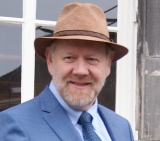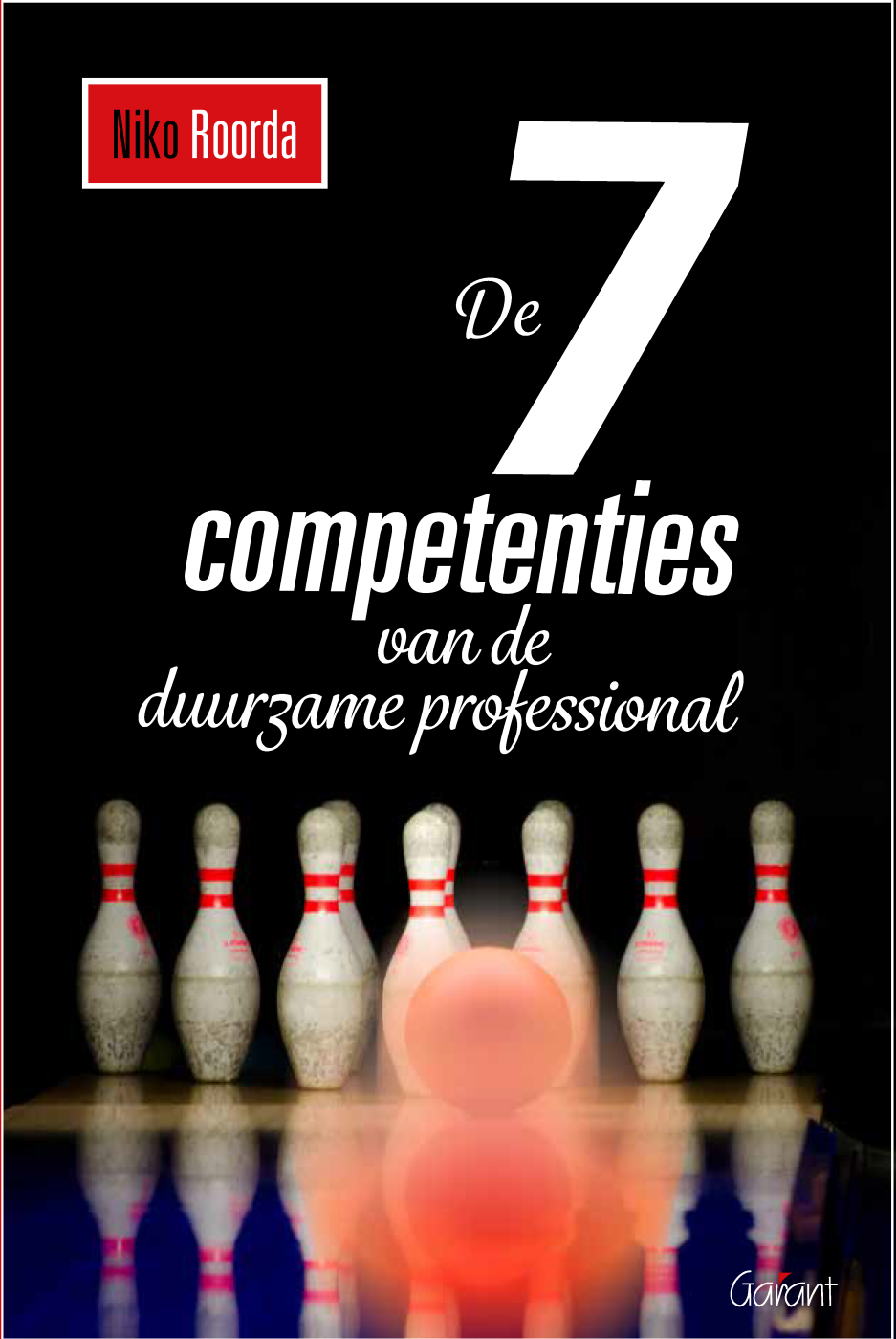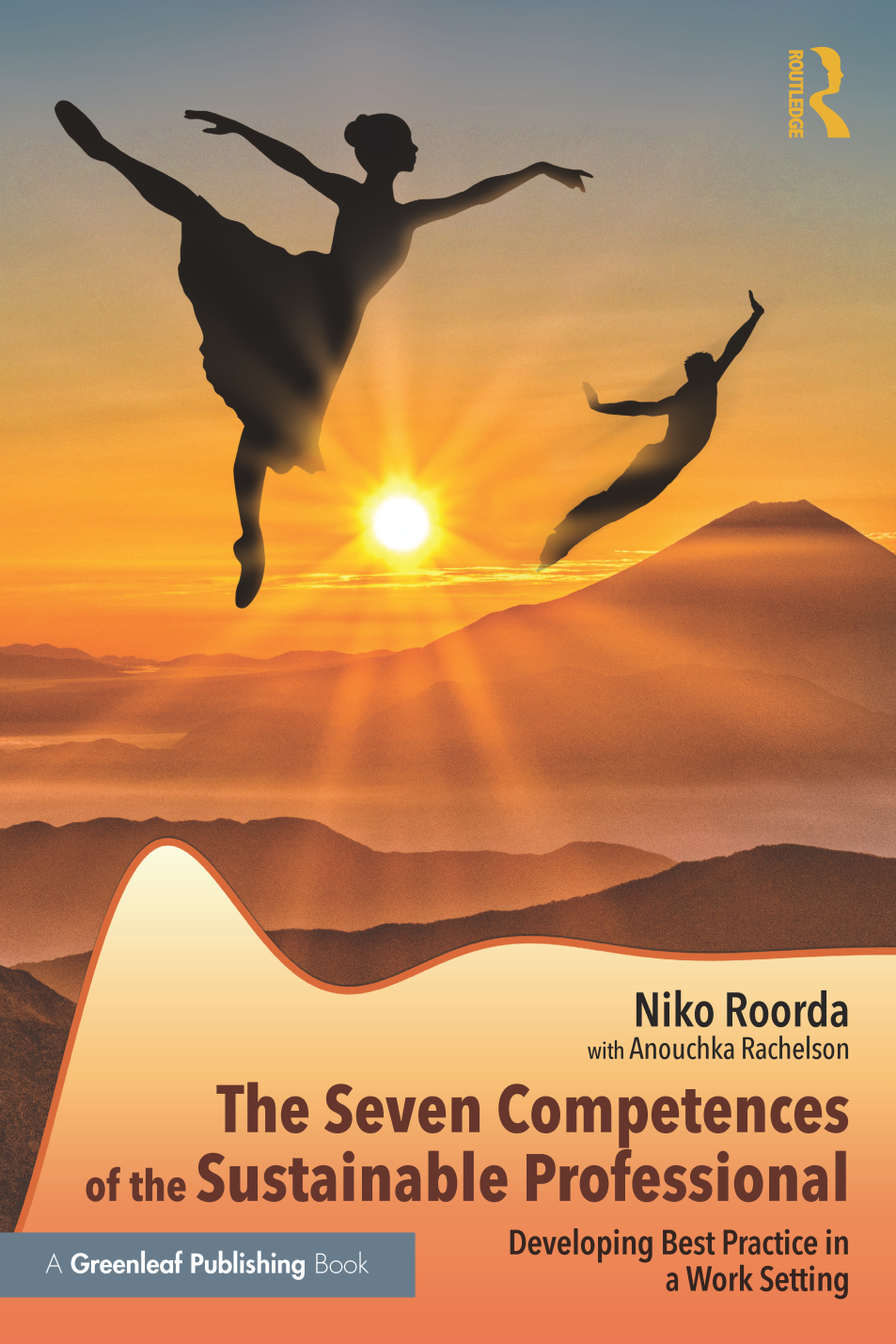|
English, 2018, with Anouchka Rachelson Routledge, UK ISBN 9780815381303 On this page: Invitation: International Book Project Taster: The first part of Chapter 1 Other webpages: The Model: RESFIA+D, the 7 competences Theoretical backgrounds: a publication (download) |
|
Professionals speaking
In 'The Seven Competences', some thirty professionals tell their story, about how they actively contribute to sustainable development through their work.
Some of them, such as actor/writer/director Teo Castellanos, are famous. Most of the professionals aren't: they are 'ordinary Americans' or 'Canadians'. Together they show that every professional, famous or not, in whatever organization or at whatever level, can contribute to sustainable development.
The stories of professionals, which came about through interviews or through texts that the narrators sent to the authors for the book, are interspersed with short pieces of easy-to-read theory.
The stories are structured according to RESFIA+D, the sustainability competence model you can read about elsewhere on this website. The book was written when, while applying RESFIA+D, participants repeatedly expressed the wish to have a series of practical examples. "How do you do it, those sustainability competences? In your actual work?" was the question Niko Roorda regularly received as a consultant and trainer. For him, this was the reason to forward the question to all sorts of professionals: in numerous professions and sectors, working from high to low in the organization. That resulted in a series of beautiful, true stories, which you can find in the book. In between the stories, you will briefly find the theoretical backgrounds of the 'Seven Competences', but only to a limited extent: this is not a theoretical textbook. If you wish, you can download the scientific backgrounds as a published article.
The International 'Seven Competences' Book Project
The 'Seven Competences' is not the only book that brings stories from competent SD professionals. There is also a Dutch book, carrying the same name (but in Dutch): De Zeven Competenties van de Duurzame Professional. While the stories in the English edition are told by US and Canadian professionals, the Dutch edition is filled with such stories by professionals living and working in the Netherlands and in Flanders, the Dutch-speaking part of Belgium.
The Dutch and American books are the first two results of an international project that aims to bring out editions in even more languages and countries, always provided by local experts with appropriate stories by professionals within their own region. You can read more about them on the corresponding project page.
The book fills a gap. On the one hand, there are numerous books that describe how companies can operate on the basis of sustainable development and CSR.
On the other hand, there are many texts that show how ordinary people, in their role as citizens or consumers, can live sustainably.
In between are the individual people in their professional roles. Little has yet been written about them, which is strange, because in the end it is always individuals who determine the course of companies, governments, non-profit organizations. And it's individuals who implement the policies that have been set out.
This book has been written for them. And also for (personnel) managers as an HRM instrument, as well as for programs in higher education.

"This book lives up to the brilliant level of thought we expect of Niko Roorda. The internationalization of this edition by Anouchka Rachelson is highly successful. There are inspiring stories here and key insights into becoming an effective sustainability professional - may this book make a big difference in your practice."
Peter Blaze Corcoran, Professor of Environmental Education and Director of the Center for Environmental and Sustainability Education, Florida Gulf Coast University; Research Fellow, Earth Charter Center for Education for Sustainable Development, USA
"A must-read for every member of the human race. Why? Unlike any other book on sustainability I have ever read, it is approachable, entertaining, smart, and thought-provoking. It argues compellingly that sustainable professionalism is the responsibility of us all and unpacks the basic building blocks of humanity."
Coro Strandberg, CSR Consultant, Strandberg Consulting, Canada
"If sustainability is to become part of the fabric of 21st-century business, we’ll need to develop a new generation of leaders who can navigate a range of complex business topics. Roorda and Rachelson provide a detailed roadmap, a clear, concise and compelling guide to what it takes to have an impact in today’s business world.
The book goes beyond the theoretical and dives into the trenches, with real stories about real professionals, punctuated by hands-on insights. This is required reading for anyone seeking to be a change-maker in business."
Joel Makower, Chairman and Executive Editor, GreenBiz Group, and Co-author, “The New Grand Strategy: Restoring America’s Prosperity, Security and Prosperity in the 21st Century”
"This timely book astutely integrates the best insights from predecessors including Steven Covey, David Brooks, and Jeffrey Sachs. The authors provide a set of self-directed stepping stones for those who aspire to not only be the change they seek in others but to dynamically institutionalize change to serve humankind within a nurtured and nurturing Planet Earth."
Michael J. Lenaghan, Professor, Miami Dade College and Board Chair, Service for Peace, USA
"The inspiring stories from the professionals that Roorda and Rachelson have brought to life in this fascinating new book create an important antidote for uneasy times and an effective guidebook for sustainability professionals, aspiring millennials, and any reader yearning for smarter uses of precious planetary resources. It just might help us accomplish a soft landing for civilization, before it’s too late."
Joel Solomon, Author “The Clean Money Revolution”, Canada
Chapter 1. One of my heroes
Vita Vanderbilt, age 27, is one of my heroes: I am deeply impressed by what she has achieved, and I will tell you why.
For a few years, Vita has been a registered nurse in a large, modern hospital. In the years that she has been employed there, she gradually started realizing that hardly any cases of child abuse were ever reported in her hospital. At first, she was okay with that; it gave her the impression that child abuse did not often occur in the city where she lived and worked. However, over the years, she began to find it more and more peculiar because, in other hospitals, even those in the same region, cases of child abuse were regularly reported. Those cases concerned physical or mental violence, negligence, and even sexual abuse – often by the victim’s own parents. It was difficult to believe that, in the vicinity of the hospital Vita was working, the number of abused children was really considerably lower than in the rest of the country. There had to be another explanation! Either the hospital staff was not as skilled in recognizing child abuse, or perhaps her colleagues may have had other reasons for not reporting more cases?
Whatever the reasons, it was quite serious. When children arrive in a hospital after having been abused, what the medical staff does may literally be a matter of life and death. If the caretakers only dress wounds and apply casts to broken bones and then send the little patients back home, they fail dramatically.
Vita initiated conversations about the problem with her colleagues in the emergency unit. Naturally, they were the ones most qualified to recognize suspicious injuries and bruises, for example, on the head, the arms, or the genitals. Most doctors and nurses Vita talked to did not seem worried, however. What you don’t see, you don’t know! Besides, from the discussions Vita had with them, it became clear that many of her colleagues considered it too much of a hassle: Even one single report of child abuse produced a ton of work. Others told her that, now and then, they had indeed noticed signs of child abuse, but they had no idea how or where to report this. Some doctors and nurses even appeared scared: What if an accused father filed a complaint against the informant, or worse, what if he stalked the nurse or doctor outside the hospital?
Nevertheless, some of Vita’s colleagues -- a few doctors, a hospital psychologist, and some nurses – agreed with her: This was not right. They formed a working group and investigated how other hospitals dealt with these kinds of situations. They also designed a training program for their colleagues. How do you recognize child abuse? In which cases are broken arms, bruises, burning wounds, scars or injured genitals indications of abuse? How can you see through stories such as “Yes, she fell down the stairs”? What do you do when you suspect child abuse? All such issues were adopted in the training program. Meetings with the hospital board were held to design a clear procedure for reporting cases of abuse. A standard report form, which had been in use in other hospitals for several years, was finally introduced.
The group worked hard to disseminate the news about the reporting procedure and its relevance. Resistance came from many doctors and nurses, but the group, supported by the hospital board, persevered. More and more colleagues grew enthusiastic. Now, a few years later, several cases of child abuse are reported weekly. Thanks to this, every year at least a hundred children are saved from a violent home situation or – in a number of cases – from death.
Real professionals and their competences
Dear reader, when I heard about what Vita had done, I was deeply impressed. She is a young woman, pretty much at the start of her professional career. She has not been assigned a managerial position. She is just one of those thousands of nurses in this huge hospital, but she minds what she sees – or rather: what she did not see. However, that was not all. When she thought that something was wrong, she started an initiative. She did not rest until - in spite of all kinds of resistance – she found allies with whom she could take on this injustice (failure in the system).
For me, this example is especially wonderful because it proves that everyone, in whatever field, can do something genuinely relevant. Vita put something in motion in the interest of people. Others have, thanks to their profession, been able to act on behalf of nature or for the environment. All of these people prove their genuine professionalism by doing more than they ought to do based on their job descriptions. These men and women act just because they think they should. They all contribute, each in their own way, to sustainable development. They show one or more extraordinary competences: skills that make them excellent professionals.
I will describe to you a few of those competences Vita showed when she struggled for the rights of injured children. One such competence was: She listened to the voice of her own consciousness. She did not uncritically perform the tasks that had been ordered by her superiors. She thought for herself about her job and her working environment, and she took the initiative because she thought she had to. Somewhere further in this book I will show you that this is an excellent example of a competence that is described as:
Employ his or her conscience as the ultimate yardstick.
In the explanation I will give you in the corresponding chapter, you will read: “You exhibit exemplary behavior and leadership thanks to your openly conscious approach,” which is exactly what Vita did. Although she did not have a management position, she established leadership by getting a small group on her side, next the hospital board, and finally a large majority of the entire staff. Another competence Vita showed was:
Personal responsibility
She did not hide behind her formal job description or behind the assignments and opinions of her superiors. She felt personally involved in what was going on in “her” hospital. There, too, she proved herself an excellent (sustainable) professional.
Competences for sustainability
In the chapter about the competence “responsibility,” you will read: “Based on your personal responsibility, you work continuously on the improvement of activities, thus contributing to sustainable development.”
Perhaps it surprises you to read the term “sustainable development” here. Does combating child abuse have anything to do with sustainable development? Sure! With what is described as “social sustainability.” Besides that, there is “ecological sustainability,” aiming at nature and the environment, and “economic sustainability,” dealing with economic stability, sustainability of companies, and prosperity of people and communities. Together they form the well-known triangle “people,” “planet,” and “profit.” I will return to this later.
Vita is one of my heroes. Look, I myself work as a professional on sustainable development. I am paid to do so. I coach people and organizations toward sustainability, and I write books about it. So for me, it is natural to contribute to sustainability, but for Vita it is not natural: Her job description does not mention it at all. And yet, she does it: She delivers a magnificent and unique contribution, in her case to social sustainability.
Her example inspired me to write this book because she illustrates how someone in an “ordinary” position in a random organization can play an exceptional role for the sake of our society. Her example proves that everybody can do that – on the condition that you truly want it, and that you keep your eyes wide open to see what can be accomplished. Everyone, no matter what profession, can contribute to sustainability. You too, dear reader!
You don’t believe me? Read on. You will see the true stories of more of my heroes. Together, they will prove what I say. You will see.
By the way, the name of Vita Vanderbilt has been changed at her request. It is not her real name; however, most of the names you will see are real. Only a few people could not or did not want their names in this book.
The civilian, the consumer, and the professional
You may be familiar with it. Various sources – e.g. books and presentations – make a distinction between two kinds of roles of individuals: the civilian and the consumer. Personally, I recognize this idea clearly. When I am thinking as a citizen about responsible behavior, driving 65 mph on a highway seems like a pretty fair speed to me, and eating healthy food appears important. However, when I am in my car, it feels good to drive faster, and in the supermarket, I don’t just buy responsible food but also those nice and shiny, sweet or spicy snacks. But maybe your mind is stronger than mine.
It is a constant struggle: the sensible citizen versus the easily tempted consumer. Actually, both have opportunities to act sustainably. The citizen may vote conscientiously and participate in discussions to support civic organizations. The consumer may carefully use electricity and water, buy fair trade products, sustainable fish and FSC-certified wood – and never more than needed.
However, there is a third role: the professional. This book addresses professionals – that is to say: you. It is true that many books and websites dealing with sustainability in the professional world have been introduced. Nearly without exception, they are about companies and organizations as a whole. Nevertheless, in the end, anything those businesses or institutions do is the work of separate individuals. Those professionals ranking high or low in the organization, from CEOs and top managers to production employees, administrative staff, nurses or janitors -- all matter. About them, the individual professionals, not much has been written yet. That is the reason for this book, in which you will find examples that will inspire you in your role as a professional. Amidst somber stories about the economy and the environment, these will bring you hope. Yes, hope, because you will see that you yourself are able to work for a better world - you -- personally.
Before I forget: on the final pages of this book, after the concluding chapter, I have inserted a list of relevant web links and a glossary. It is always nice to know this right from the start and not to discover it at the end…
RESFIA+D: the seven competences of the sustainable professional
The competences I will tell you about are called “RESFIA+D.” That is an abbreviation. The first six characters, “R‑E-S-F-I-A,” represent general competences, i.e. those you may expect from any professional. The seventh, “D,” is short for “Disciplinary.” That is to say: related to separate professions or disciplines. At the end of the book, in Chapter 14, I will return to RESFIA+D in the shape of a quick self-test that you can fill out in order to learn more about yourself as a professional. Here, at the end of Chapter 1, I present to you a brief overview so that you know what to expect. Right after this overview, in Chapter 2, I will start with the first set of competences, belonging to the “R” of “Responsibility.” Here is the overview. Please notice the initials.
Responsibility – A sustainably competent professional bears responsibility for his or her own work.
- Create a stakeholder analysis on the basis of the consequence scope and the consequence period
- Take personal responsibility
- Be held personally accountable with respect to society (transparency)
Emotional intelligence – A sustainably competent professional empathizes with the values and emotions of others.
- Recognize and respect his or her own values and those of other people and cultures
- Distinguish between facts, assumptions, and opinions
- Cooperate on an interdisciplinary and transdisciplinary basis
Systems orientation – A sustainably competent professional thinks and acts from a systemic perspective.
- Think about systems: flexibly zoom in and out of issues, i.e. thinking analytically and holistically in turn
- Recognize flaws in the fabric and sources of vigor in systems; have and ability to use the sources of vigor
- Think integrally and chain oriented
Future orientation – A sustainably competent professional works and thinks on the basis of a perspective of the future.
- Think in different time scales: flexibly zoom in and out of short and long term approaches
- Recognize and utilize non-linear processes
- Think innovatively, creatively, out of the box
Involvement – A sustainably competent professional is personally involved in sustainable development.
- Consistently involve sustainable development in his or her own work as a professional (sustainable attitude)
- Passionately strive toward dreams and ideals
- Employ his or her conscience as the ultimate yardstick
Action skills – A sustainably competent professional is decisive and capable of acting.
- Assess the unquantifiable and make decisions
- Deal with uncertainties
- Act when the time is right, and not against the current: “action without action”
Disciplinary competences. Select which competences are related to your discipline and/or profession.
- ....
- ....
- ....



